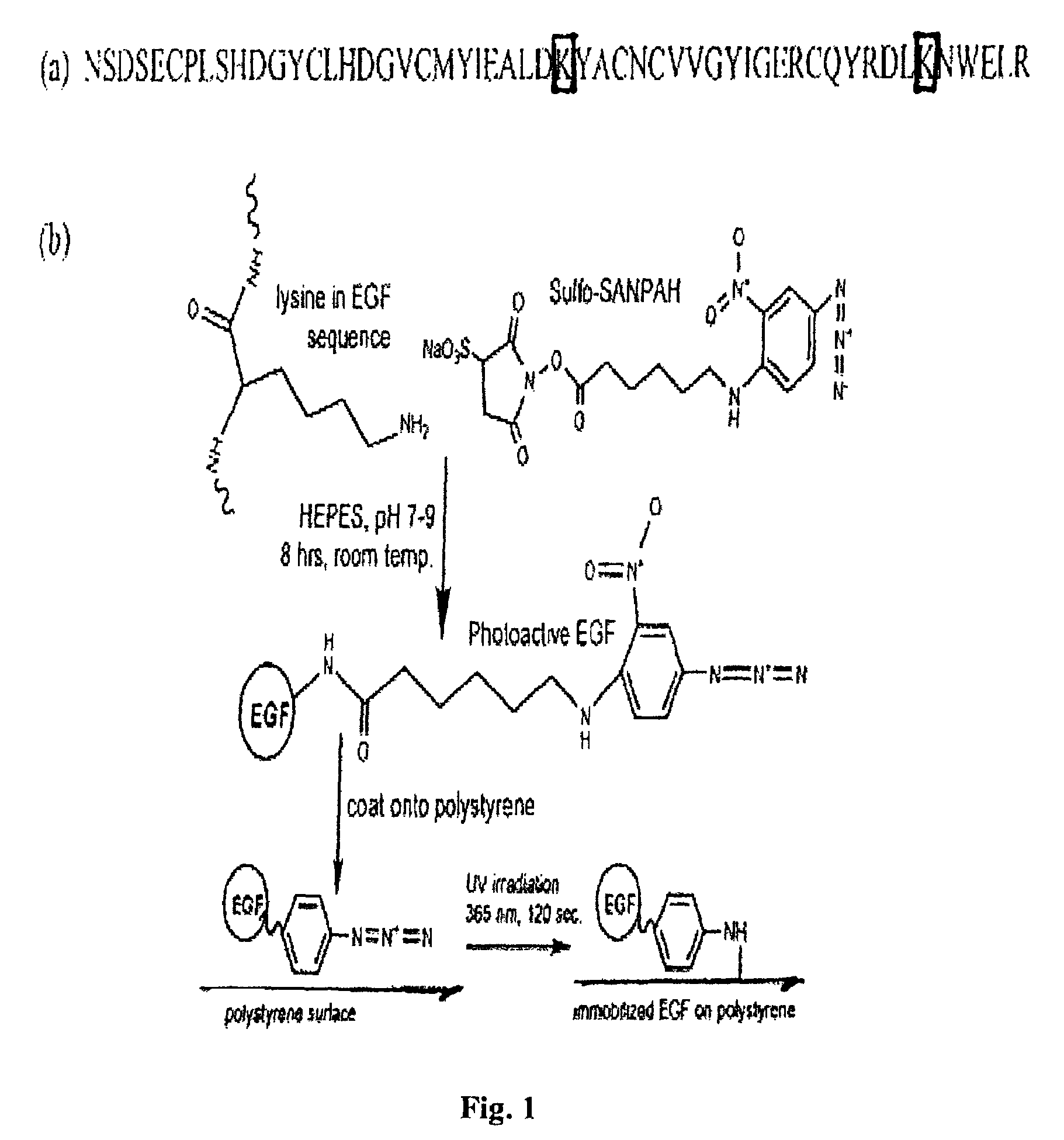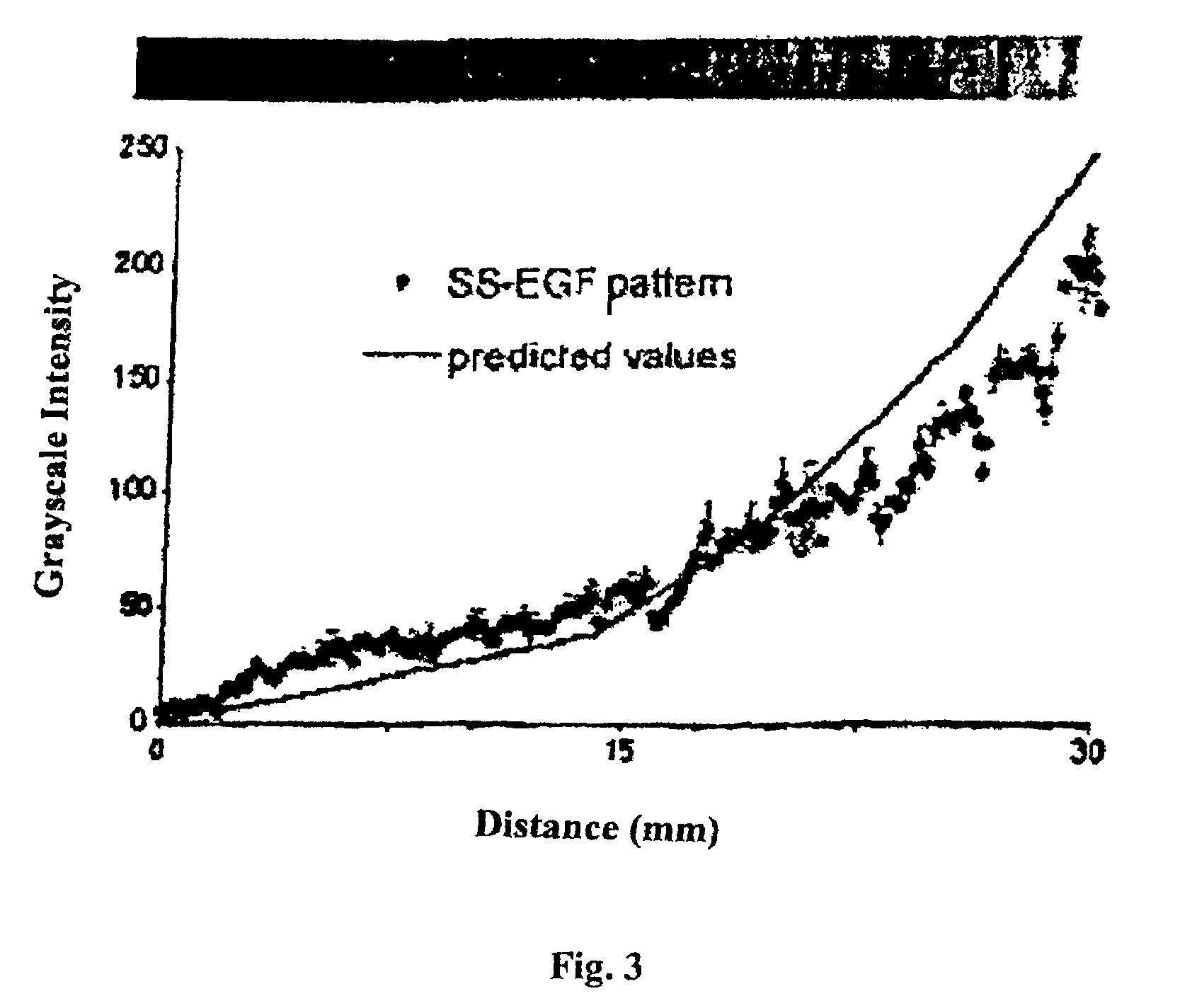Patterned gradient wound dressing and methods of using same to promote wound healing
a gradient wound dressing and gradient technology, applied in the field of wound healing, can solve the problems of increasing the cost of reapplication of growth factors, reducing the reducing the available amount of topically applied basic fibroblast growth factors in solution, etc., to achieve the effect of improving the promotion of wound healing
- Summary
- Abstract
- Description
- Claims
- Application Information
AI Technical Summary
Benefits of technology
Problems solved by technology
Method used
Image
Examples
example 1
Materials and Methods
[0081]All chemicals were obtained from Sigma-Aldrich (St. Louis, Mo.) unless otherwise noted.
[0082]Cell culture. Immortalized human keratinocytes (HaCaTs, courtesy of N. Fusenig, DKFZ, Heidelberg, Germany) were cultured and maintained in Dulbecco's modification of eagle's medium (DMEM), 10% fetal bovine serum (FBS), 1% glutamine, and 1% penicillin / streptomycin at 37° C., 5% CO2.
[0083]EGF modification. Recombinant human EGF (Peprotech Inc., Rocky Hill, N.J.) having the amino acid sequence of SEQ ID NO:1 (see FIG. 1) was rendered photoactive via conjugation to Sulfo-SANPAH (sulfosuccinimidyl-6-[40-azido-20-nitrophenylamino]hexanoate; Pierce Biotechnology Inc., Rockford, Ill.). Sulfo-SANPAH (SS) is a heterobifunctional crosslinker containing a photosensitive phenyl azide group on one end and an amine-reactive N-hydroxysuccinimide on the other (FIG. 1). Photoreactive EGF was synthesized via the reaction of primary amine groups of EGF with the N-hydroxysuccinimide fu...
example 2
EGF Modification
[0092]Spectroscopy was used to confirm conjugation of SS to EGF, as well as determine the optimal UV exposure time for complete photolysis (i.e., tethering) of the SS. Conjugation of SS to EGF was confirmed by an absorption spectrum displaying peaks at 262 nm (corresponding to the photoactive phenyl azide of SS) and 280 nm (corresponding to EGF). Owing to the breadth of the 262 nm peak and the coupling of multiple SS groups to a single EGF molecule, the EGF peak appears as a shoulder, rather than as an isolated peak (FIG. 2). To optimize the UV exposure time needed for photolysis of the phenyl azide (and hence covalent tethering to our surface), the disappearance of the 262 nm peak was measured as a solution of SS-EGF was exposed to UV light for varying amounts of time. The loss of the phenyl azide peak of SS upon UV exposure is a standard measure of phenyl azide photolysis.30,31 Within 1 minute of UV exposure, the peak dropped dramatically, indicating partial photol...
example 3
Gradient Characterization
[0093]Photo-immobilization of fluorescently labeled SS-EGF to polystyrene plates via the phenylazide functionality of SS was successfully completed in the desired gradient pattern (FIG. 3). The actual slope of the EGF gradient (as measured by image quantification) correlated well with the predicted gradient slope (i.e., the gradient slope of the photomask). Immobilized EGF increased steadily along the length of the gradient path (i.e., along the x-axis), while remaining homogeneous across the width of the path (i.e., along the y-axis), as desired (FIG. 3).
[0094]An ELISA for hEGF yielded a quantitative description of the total amount of EGF tethered across each gradient pattern. Combining this information with gradient intensity curves, the concentration of EGF at any point along the gradient can be calculated. FIG. 4 illustrates the experimentally calculated EGF concentration at a few example points along the gradient paths used in the cell migration experim...
PUM
| Property | Measurement | Unit |
|---|---|---|
| pH | aaaaa | aaaaa |
| wavelength | aaaaa | aaaaa |
| concentration | aaaaa | aaaaa |
Abstract
Description
Claims
Application Information
 Login to View More
Login to View More - R&D
- Intellectual Property
- Life Sciences
- Materials
- Tech Scout
- Unparalleled Data Quality
- Higher Quality Content
- 60% Fewer Hallucinations
Browse by: Latest US Patents, China's latest patents, Technical Efficacy Thesaurus, Application Domain, Technology Topic, Popular Technical Reports.
© 2025 PatSnap. All rights reserved.Legal|Privacy policy|Modern Slavery Act Transparency Statement|Sitemap|About US| Contact US: help@patsnap.com



